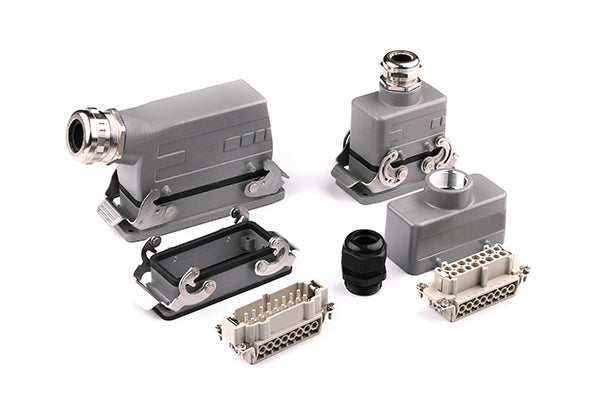Heavy Duty connector
Heavy Duty connector
Heavy-Duty Connector (HDC): A Brief Introduction
A Heavy-Duty Connector (HDC), also often known as an Industrial Connector or by brand names like Harting Han®, Amphenol EPIC®, or Phoenix Contact COMBICON®, is a modular connector system designed specifically to provide a robust, reliable, and highly protected connection in the most demanding industrial and commercial environments. They are the workhorses of industrial automation, built to outperform standard connectors.
Core Philosophy and Key Advantages:
The primary design goal of an HDC is to simplify wiring, enhance reliability, and reduce downtime in harsh applications. They replace complex, time-consuming, and less reliable wiring methods like individual glanded cables or junction boxes.
-
Extreme Robustness: Built to withstand mechanical stress, including intense vibration, shock, and frequent mating cycles, far better than standard connectors.
-
Superior Environmental Protection: Offer very high Ingress Protection (IP) ratings, typically IP65, IP66, IP67, and even IP69K (for high-pressure, high-temperature wash-downs). They are sealed against dust, moisture, and jets of water.
-
Modularity and Flexibility: Their key feature is a modular design. Users can configure a single connector housing with a custom mix of:
-
Power contacts (high current)
-
Signal and data contacts (e.g., Ethernet, Profibus)
-
Coaxial contacts (for RF)
-
Pneumatic or fluid couplings (Hybrid Connectors)
-
-
Ease of Installation and Maintenance: Modules can be pre-wired and tested on the bench. Entire machine modules can then be quickly connected or disconnected on the factory floor, drastically reducing installation time and machine downtime for maintenance.
-
Safety: Many designs feature advanced locking mechanisms (e.g., bayonet, screw-lock) that prevent accidental disconnection and often include a protective shutter to prevent contact with live pins when unmated.
Key Components of an HDC System:
An HDC system is comprised of several integrated parts:
-
Housing (Shell): The robust outer shell, typically made of die-cast zinc alloy or high-strength engineering plastics. It provides the mechanical structure and environmental seal.
-
Hood (Plug Housing): Contains the male contacts and is attached to the cable.
-
Header (Receptacle Housing): Contains the female contacts and is mounted onto the machine or control cabinet.
-
-
Insert Modules: The heart of the modular system. These are plastic blocks that hold the actual electrical contacts. Different modules are used for power, signal, or data. They snap into the housing.
-
Contacts (Terminals): The pins and sockets within the insert modules. They are designed for high current-carrying capacity and reliable mating, often using a gas-tight crimp connection.
-
Locking Mechanism: A secure coupling system, most commonly a robust bayonet-style lock that ensures a vibration-proof connection and provides tactile and audible feedback when fully mated.
-
Sealing System: Multiple sealing points, including between the housing halves, at the cable gland entry, and between different modules, ensure the high IP rating.
Common Industry Standards:
While many HDCs are proprietary, their dimensions and performance often conform to international standards to ensure interoperability between manufacturers. The most common standard is:
-
IEC 61076-2: Specifies the dimensions and requirements for circular connectors with inner push-pull locking, which covers many HDC form factors.
Typical Applications:
Heavy-Duty Connectors are essential anywhere equipment faces harsh conditions:
-
Industrial Automation & Robotics: Connecting robotic arms, CNC machines, sensors, and motor drives.
-
Factory Floor Machinery: Presses, conveyors, and packaging equipment.
-
Process Control & Instrumentation
-
Rail Transportation: For onboard and trackside equipment.
-
Renewable Energy: In wind turbines and solar inverter systems.
-
Outdoor Infrastructure: Lighting, HVAC systems, and construction equipment.
無法載入取貨服務供應情況
有庫存
查看完整資訊
